This step by step woodworking project is about free single lean to carport plans. I have designed this sturdy carport with a lean to roof, so you can protect your vehicle from the weather elements. Make sure you take a look of the local building codes, so you make sure you comply with the legal regulations. My plans come with step by step instructions and you can easily adjust all the dimensions to suit your needs. See my other DIY projects HERE.
We recommend you to invest in the best materials you could afford. Therefore, you should buy weather-resistant lumber, such as pine or cedar. Always take accurate measurements before adjusting the size of the components at the proper size. Drill pilot holes trough the components before inserting the wood screws, to prevent the wood from splitting. See all my Premium Plans HERE.
Made from this plan
Lean to Carport – Video!
Single Car Lean to Carport – Free DIY Plans
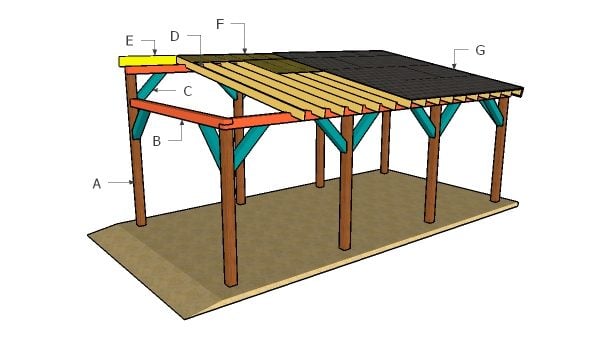
Building a lean to carport
Materials
- A – 4 pieces of 6×6 lumber – 132″ long, 4 pieces – 156″ long POSTS
- B – 2 pieces of 6×6 lumber – 288″ long, 2 pieces – 138 1/2″ long BEAMS
- C – 16 piece of 6×6 lumber – 36″ long BRACES
- D – 19 pieces of 2×6 lumber – 168″ long RAFTERS
- E – 2 pieces of 1×8 lumber – 169 1/2″ long, 2 pieces – 288″ long TRIMS
- F – 8 pieces of 3/4″ plywood – 48″x96″ long, 2 pieces – 48″x48″ long, 2 pieces – 24″x96″ long, 2 pieces – 24″x48″ long ROOF
- G – 35o sq ft of tar paper, 350 sq ft of asphalt shingles ROOFING
- 6 pieces of 6×6 lumber – 12′
- 4 pieces of 6×6 lumber – 14′
- 2 pieces of 6×6 lumber – 24′
- 6 pieces of 6×6 lumber – 10′
- 2 pieces of 1×8 lumber – 16′
- 4 pieces of 1×8 lumber – 12′
- 11 pieces of 3/4″ plywood – 4’x8′
- 19 pieces of 2×6 lumber – 14′
- 350 sq ft of tar paper, 350 sq ft of asphalt shingles
- tube form, post anchor
- 500 pieces of 2 1/2″ screws, 1 1/4″ screws, 6″ screws
- rafter ties
- wood glue, stain/paint, wood filler
Tools
- Safety gloves, glasses
- Miter saw, jigsaw
- Chalk line, tape measure, spirit level, carpentry pencil
- Drill machinery and drill bits
Time
- One Day
Related
Building a single car lean to carport
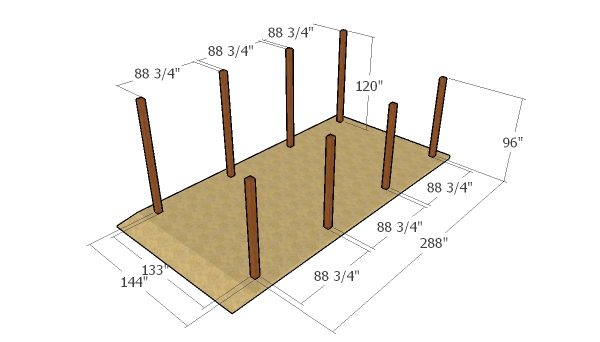
Laying out the posts
The first step of the project is to layout the posts for the carport. Use string and batter boards to layout the posts for the single car carport. Apply the 3-4-5 rule to the corners so you make sure they are right-angled. Moreover, you need to measure the diagonals and make adjustments so they are perfectly equal.

Anchoring the post into concrete
Setting the 6×6 posts in concrete is essential for the rigidity of the carport. As you can easily notice in the diagram, we recommend you to dig 3′ deep holes and to pour 2″ gravel on the bottom. Install the tube forms to the holes. Secure the posts with braces before filling the forms with concrete.
Alternatively, you could use posts anchors. Secure the metal anchors into concrete, as to lock the wooden posts into place properly. Align everything with attention and with great care.
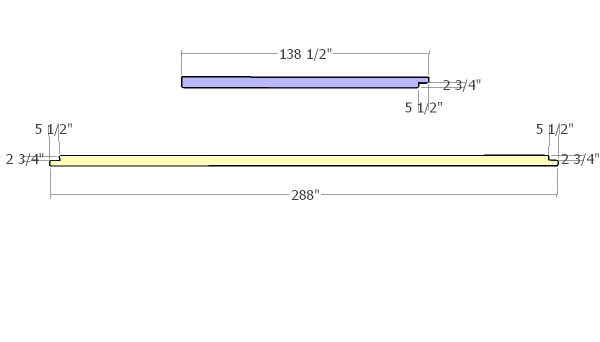
Top plates
Build the beams for the sides of the carport from 6×6 lumber. Mark the cut lines and then make 2″ deep parallel cuts inside the areas. Use a chisel to remove the excess material and then smooth the surface.
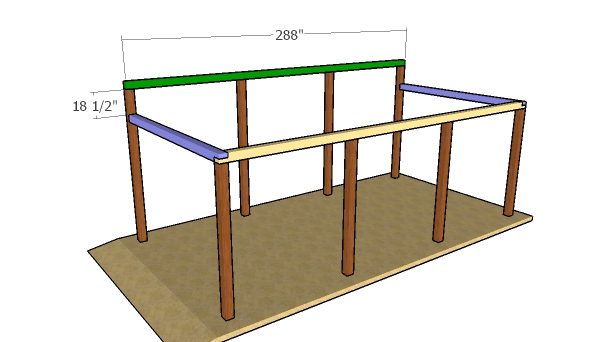
Fitting the plates
Fit the beams the top of the posts and then align the edges with attention. Drill pilot holes through the beams and then insert 5 1/2″ screws into the posts. Make sure the corners are right angled.

Attaching the braces
Fit the 6×6 braces to the posts, as shown in the diagram. Use a saw to make the 45 degree cuts at both ends of the braces. Make sure the posts are plumb, check if the corners are square and then secure the braces into place with 3 1/2″ screws, after drilling pilot holes.

Building the rafters
Build the rafters for the single carport from 2×6 lumber. Make the notches to the rafters, so you can fit them into place tightly.
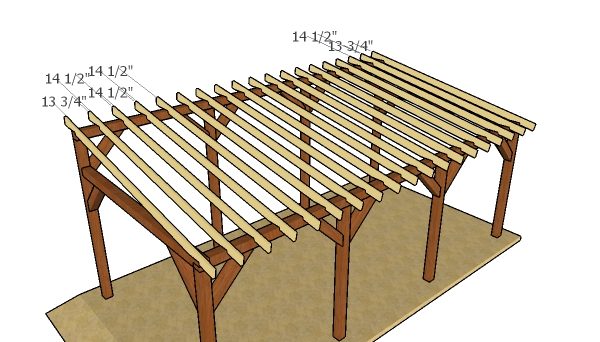
Fitting the rafters
Fit the trusses to the top of the carport and place them equally spaced (every 16″ on center). Use a spirit level to make sure the trusses are plumb. Use rafter ties to secure the trusses to the support beams.
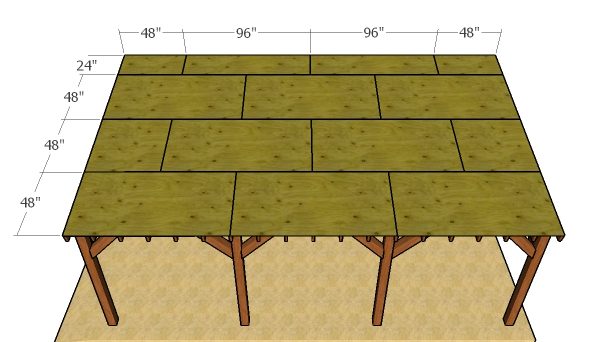
Fitting the roof sheets
Fit the 3/4″ plywood sheets to the top of the lean to carport roof. Align the edges with attention and start installing the sheets with the bottom part. Leave no gaps between the sheets and insert 1 5/8″ screws to lock them into place tightly.
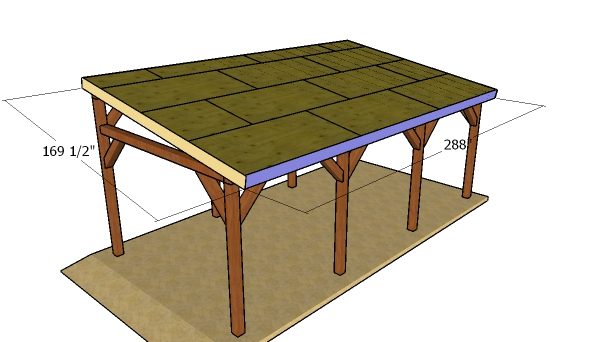
Fitting the roof trims
Fit 1×8″ trims to the exterior of the roof. Align the edges with attention and secure them into place with 2 1/2″ screws. Drill pilot holes before inserting the screws to prevent the wood from splitting.
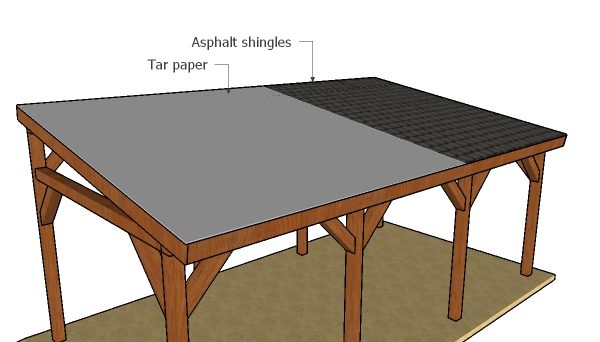
Fitting the roofing
Cover the roofing sheets with tar paper. Install the tar paper starting with the bottom of the roof and make sure the strips overlap for at least 2″. In addition, fit a 12” strip over the top ridge. Install the shingles starting with the left- bottom of the roof, after fitting the starting course. Use roofing tacks to secure the shingles into place.
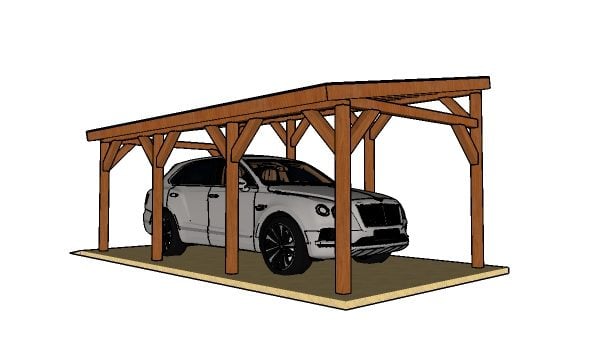
How to build a lean to carport
Last but not least, you need to take care of the finishing touches. Fill the holes and the dents with wood putty and then smooth the surface with 120-220 grit sandpaper. Apply a few coats of paint or stain over the components to enhance the look of the project and to protect the components from the elements.
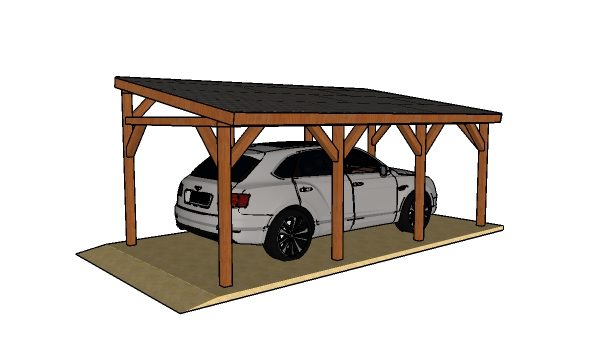
12×24 Do It Yourself Lean to Carport Plans
This carport with a gable roof is large enough for one car. The large roof with generous overhangs is ideal for a car, as it will protect it from rain and excessive sun. If you like my project, don’t forget to SHARE it on Facebook and Pinterest.
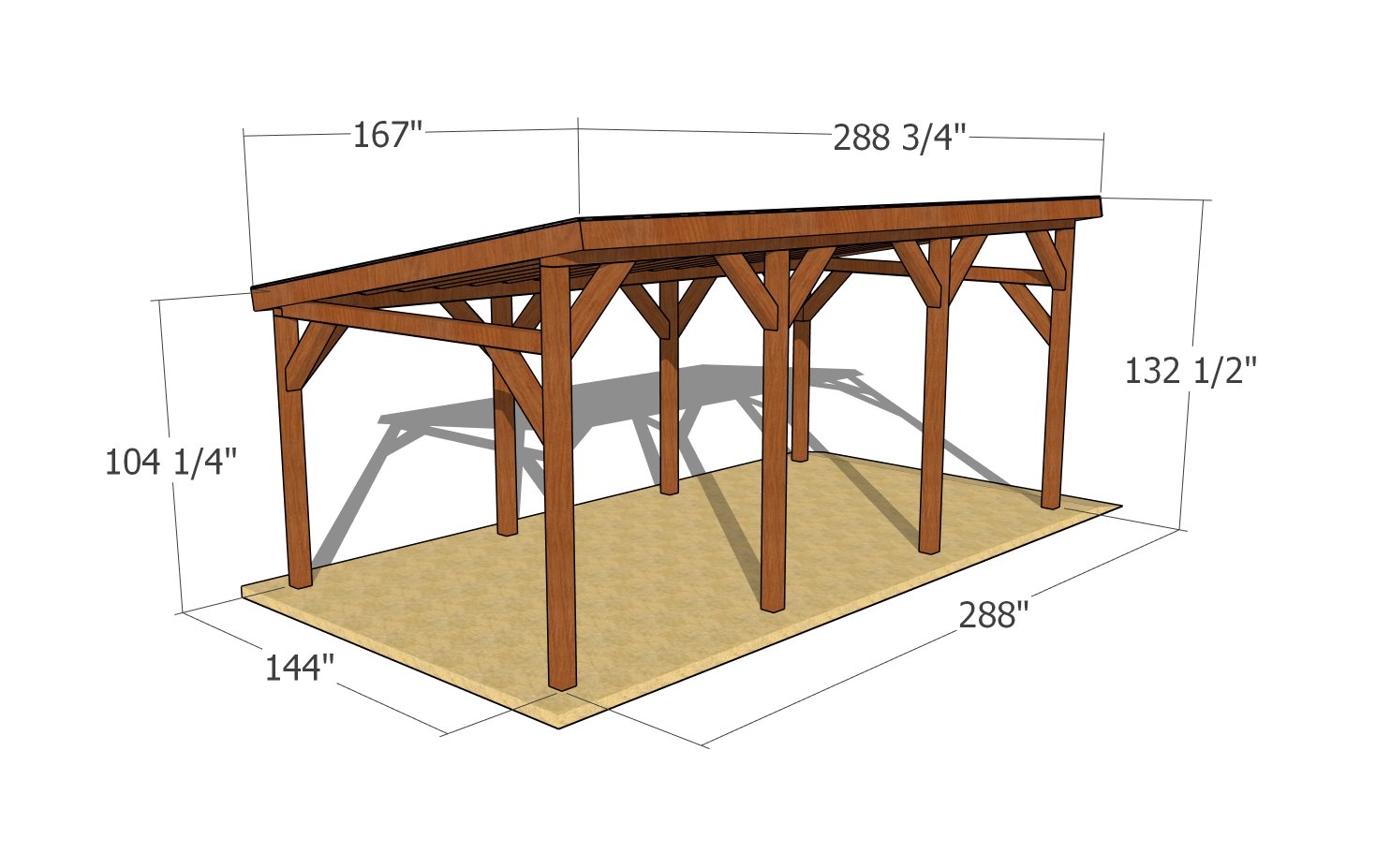
12×24 Do It Yourself Lean to Carport Plans – dimensions

12×24 carport plans
My best tips on building a single lean to carport:
A single lean-to carport is a simple and cost-effective way to protect your vehicle from the elements. With its slanted roof design, a lean-to carport is easy to build and integrates seamlessly with existing structures like your home or garage. Whether you’re looking for extra shelter for your car or a shaded outdoor workspace, here are my best tips for building a sturdy and stylish single lean-to carport.
1. Plan and Design Your Lean-To Carport
- Decide on the Carport Size: The standard size for a single carport is 10-12 feet wide and 20 feet long, providing enough room for one vehicle. Adjust the size depending on the available space and your needs.
- Choose the Roof Pitch: Lean-to carports have a single sloped roof that directs water away from the structure. A slope of at least 2-3 inches per foot ensures proper water drainage.
- Select the Location: Choose a flat area next to your home, garage, or another sturdy structure for the carport to attach to. Make sure the location has adequate drainage and is easily accessible from your driveway.
- Check Local Building Codes: Before starting, check with your local authorities for any permits or building code requirements. Rules may dictate how close the carport can be to your property line, as well as height and size limits.
2. Choose the Right Materials
- Pressure-Treated Lumber or Metal Posts: Pressure-treated lumber is a durable, cost-effective choice for the carport frame. For a more modern look, consider steel or aluminum posts.
- Roofing Material: Corrugated metal sheets are popular for lean-to carports because they’re lightweight, durable, and easy to install. You can also use polycarbonate panels, asphalt shingles, or plastic roofing materials, depending on your budget and preferences.
- Concrete for Post Anchors: For stability, use concrete to anchor the posts securely in the ground. This ensures that the carport remains sturdy, even in bad weather.
- Tools: You’ll need basic tools like a saw, drill, hammer, level, post-hole digger, measuring tape, and ladder.
3. Mark and Prepare the Site
- Mark the Carport’s Footprint: Use stakes and string to mark the carport’s footprint on the ground. Measure carefully and ensure that the layout is square and aligned with your home.
- Clear the Area: Remove any grass, plants, or debris from the marked area. For better durability and aesthetics, you can pour a concrete slab or use gravel for the carport floor.
4. Dig Post Holes and Set the Support Posts
- Dig Post Holes: Use a post-hole digger to dig holes for the support posts along the perimeter of the carport. The holes should be at least 2-3 feet deep to ensure stability, especially in regions with frost or unstable soil.
- Pour Concrete for Footings: Set the posts in the holes and pour concrete around them. Use a level to make sure the posts are plumb (vertical) and brace them with temporary supports while the concrete sets. Let the concrete cure for at least 24-48 hours.
- Optional: Use Post Brackets: If you’re attaching the posts to an existing concrete pad or deck, use metal post brackets to anchor the posts securely without digging.
5. Install the Ledger Board
- Attach the Ledger Board to the Structure: The ledger board is a key structural component that attaches the lean-to roof to your house, garage, or shed. Bolt the ledger board directly to the wall studs using lag screws or bolts. The ledger must be level and securely fastened, as it will support the roof rafters.
- Ensure a Water-Tight Seal: Install flashing above the ledger board to prevent water from seeping behind it and damaging your home or garage wall.
6. Install the Roof Beams
- Attach Horizontal Beams to the Posts: Secure horizontal support beams (usually 2×6 or 2×8) across the tops of the support posts. These beams will support the roof rafters.
- Use Carriage Bolts or Lag Screws: Attach the beams to the posts using strong hardware like carriage bolts or lag screws. Make sure the beams are level and securely fastened to prevent sagging.
7. Install the Rafters
- Cut and Install the Roof Rafters: Measure and cut roof rafters (typically 2×4 or 2×6) to span between the ledger board and the support beams. Space the rafters 16-24 inches apart depending on the type of roofing material you’ll be using.
- Notch the Rafters (Optional): To give the rafters a stronger seat on the support beams, you can notch them to fit snugly over the beams. This helps prevent shifting and adds stability to the structure.
- Attach Rafters to the Ledger and Beams: Secure the rafters to the ledger board and beams using joist hangers, hurricane ties, or screws. Ensure the rafters are evenly spaced and properly aligned for a level roof.
8. Attach the Roofing Material
- Lay Down Roofing Panels or Shingles: Begin installing your roofing material from the bottom edge of the roof and work your way up. Overlap the panels or shingles according to the manufacturer’s instructions to ensure proper water runoff.
- Secure the Roofing Material: Use screws or nails to secure the roofing material to the rafters. For metal roofing, use screws with rubber washers to prevent leaks.
- Install a Ridge Cap (If Needed): If your roof has a slight ridge or peak, install a ridge cap to protect the seam from water.
9. Add Finishing Touches
- Install Gutters (Optional): To manage water runoff, you can install gutters and downspouts along the roof edge. This will protect the area beneath the carport from water pooling and erosion.
- Paint or Stain the Structure: For a polished look and added weather protection, paint or stain the wood posts and beams. Use a weather-resistant finish to protect the wood from moisture and UV damage.
- Add Side Panels or Lattice: If you want extra protection from the elements or a bit more privacy, consider adding side panels or lattice to one or more sides of the carport. This can also enhance the overall look of the structure.
10. Anchor and Secure the Carport
- Anchor the Posts to Concrete (For Stability): If your carport is in an area prone to strong winds, ensure that the posts are securely anchored to the ground or a concrete pad. Use concrete footings or metal anchor brackets to prevent the carport from shifting.
- Add Cross Bracing: For extra strength, install diagonal cross braces between the posts and beams. This will help prevent the structure from swaying during strong winds or heavy use.
11. Maintenance Tips
- Inspect Regularly: Check the carport periodically for signs of wear, including loose screws, rust on metal components, or cracks in the roofing material. Tighten or replace any damaged parts as needed.
- Clean the Roof: Regularly remove leaves, dirt, and debris from the roof to prevent damage and extend its life. A clean roof also ensures proper water runoff.
Building a single lean-to carport is a simple and rewarding DIY project that adds practical protection for your vehicle while enhancing your home’s exterior. With proper planning, quality materials, and attention to detail, you can create a carport that’s not only functional but also adds value to your property. By following these steps, you’ll have a sturdy, attractive structure that lasts for years.
Thank you for reading our project about free lean to single carport plans and I recommend you to check out the rest of the projects. Don’t forget to LIKE and SHARE my projects with your friends, by using the social media widgets.

2 comments
Need plans for a two car carport, like the single carport.Thank Yoi
Could this built using 4x4s instead of 6x6s if I adjusted the span?